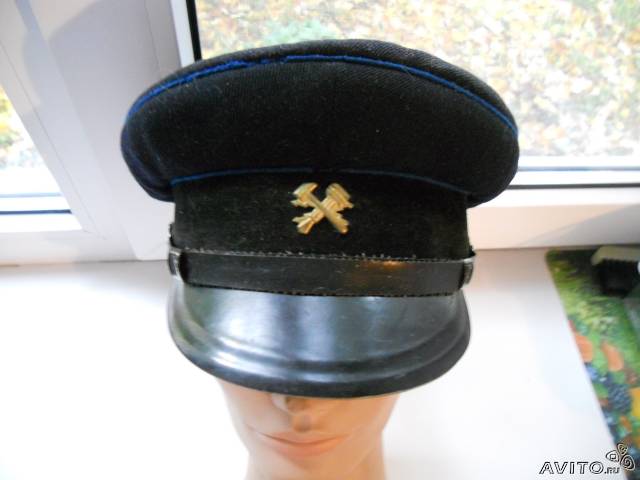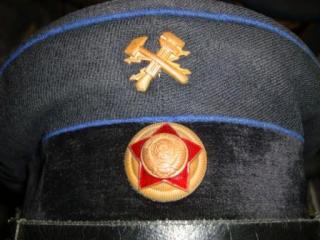 Caps of the Ministry of Communications
Caps of the Ministry of CommunicationsThis Ministry also had subordinate to it the Courier Service (later renamed - the Special Communication Service or "спецсвязи"). In 1947, the Courier Service was subordinated to the newly formed Ministry of Internal Affairs of the USSR. It was charged with providing communications for the Council of Ministers of the USSR, mail delivery to defense ministries and state committees, special deliveries to state industries and from 1958 - for overseas delivery of technical documents and articles to friendly Socialist states. In April 1960, in connection with the abolition of the Union Ministry of Internal Affairs, portions of this organization were transferred to the Ministry of Communications of the USSR. At least one other "Courier Service" did, however, remain subordinate to the MVD - apparently responsible for many if not most of subsequent courier deliveries for the Armed Forces and Security Services.
As with so many of the non-military ministries, information on Communications Ministry uniforms is quite sparse. Some extracts do exist for 1948 and 1956 but are sadly lacking for other years. Nevertheless, sufficient uniform items do exist in collections (mostly in the Former USSR) to allow me to at least partially describe the caps and insignia used by its personnel. For example, we are fortunate in that the color scheme of their caps remained the same for the entire post-war period: that being a dark blue (often almost black) crown and band with medium blue piping. This scheme was very similar to that used by the Mining Ministries - although all Communications caps had black velvet bands (vice a mix of velvet and wool used by Mining) and the blue piping was a slightly different shade of blue (really only discernable if the two colors are held side by side).
Ministry of Communications
Non-Technical Personnel
1948-1955
Shown here is a cap described in the 1948 Communications Ministry regulations. As with successive regulations, dark blue/black was the standard uniform color, shown here in the crown. The band was black velvet for all ranks and piping was medium (cornflower) blue. The circular M-1948 Communications cockade pinned to the band was stamped brass with a red enamel star and superimposed great seal of the USSR showing 16 republic banners. The visor is semi-circular black lacquered fiberboard while the chinstrap is black oilcloth. Old-style one-piece cast brass buttons embossed with the Communications symbol secure the strap in place. Rare
Ministry of Communications
All personnel
1956-77
According to 1956 regulations, the cap and insignia combination shown here became standard for all personnel of the Ministry, regardless of grade. As you can see, the emblem previously worn on the crown of technical graduates' caps was now moved to the band and the circular cockade was abolished. In 1978, personnel of the Special Communications Service were authorized different insignia, but the rest of the Ministry "apparently" continued to wear aluminum versions of this insignia.
This specific cap dates from the late 50s or early 1960s. It has the very small crown in a dark blue wool blend, as well as a small semi-circular black fiberboard visor popular at the time. The band is black velvet and the thin piping is medium blue. As you can see from the close-up below, the buttons were unique to this service, depicting a hammer and sickle superimposed over a lightning bolt. Older buttons (as shown her) are one-piece domed castings in brass. The cap insignia is also stamped brass. I've also attached a picture of the interior of this cap showing a very rare full-color Kharkov maker's label. Rare
|
|
Special Communications Service of Ministry of Communications
Junior and Middle Command Staff
1978-91
According to the 1998 Russian pamphlet "Cockades" - the Special Communications Service was authorized new cap insignia in 1978 (unfortunately no other post-1956 reference seems to exist on Communications' uniforms; although observation of a number of actual caps seems to support this approximate date). These changes brought back the circular cockade used from 1948-1955 (although with a slightly modified depiction of the Great Seal of the USSR) but with a completely new crown emblem. All emblems were now also in anodized aluminum vice the heavier tombac (aka red copper) used earlier.
The dark blue crown is the larger size that became standard across all uniformed services in the 1970s. Piping remains in medium blue and the band is black velvet.
Also reflecting its later date of manufacture, this cap has a larger black plastic visor. While the new-style crown "wings" now became standard for all
staff (command) grades of this service, the combination of the circular cockade without a wreath and the black plastic/oilcloth chinstrap identify the owner as a junior or
mid-level staffer.
Scarce
Special Communications Service of Ministry of Communications
Senior and Highest Command Staff
1978-91
A counterpart to the previously described cap, this cap would have been worn by a senior or highest-grade staff member (field officer and general-officer equivalents).
The only difference between the caps is that this 1988-dated one has a cockade surrounded by a wreath and gilt filigree cords vice the simple round cockade and black strap worn by more junior personnel.
As previously mentioned, the crown emblem is the same. The buttons are also later two-piece brass versions, slightly smaller than the one-piece buttons found on the 1956-1977 cap discussed above.
Scarce

|
While unconfirmed, it appears the rank and file (private-equivalent) component of the Special Communications Service wore caps similar to the one shown here with the crossed hammer and wrench with lightning bolts emblem. This same style was also "probably" the standard cap worn by other Communications Ministry personnel out to 1991. Unfortunately, I can't confirm this due to lack of published regulations. While originally produced in brass, an aluminum version of this emblem became standard in 1974. |
| To finish up this section, I've included a series of pictures below showing different versions of the insignia described above - reflecting their age of manufacture. Ideally, when collecting these caps you want to ensure the age of the emblem matches the age of the cap. |
|
|
|
The older M56 stamped brass emblem is at the top; the M74 cast anodized aluminum version is shown below. |
|
|
|
While both of these are made of anodized aluminum, the first-style wings at the top are thinner and better cast than the last version shown at the bottom. |
